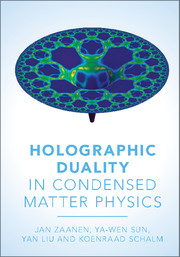Book contents
- Frontmatter
- Contents
- Preface
- 1 Introduction
- 2 Condensed matter: the charted territory
- 3 Condensed matter: the challenges
- 4 Large-N field theories for holography and condensed matter
- 5 The AdS/CFT correspondence as computational device: the dictionary
- 6 Finite-temperature magic: black holes and holographic thermodynamics
- 7 Holographic hydrodynamics
- 8 Finite density: the Reissner–Nordström black hole and strange metals
- 9 Holographic photoemission and the RN metal: the fermions as probes
- 10 Holographic superconductivity
- 11 Holographic Fermi liquids: the stable Fermi liquid and the electron star as holographic dual
- 12 Breaking translational invariance
- 13 AdS/CMT from the top down
- 14 Outlook: holography and quantum matter
- References
- Index
14 - Outlook: holography and quantum matter
Published online by Cambridge University Press: 05 November 2015
- Frontmatter
- Contents
- Preface
- 1 Introduction
- 2 Condensed matter: the charted territory
- 3 Condensed matter: the challenges
- 4 Large-N field theories for holography and condensed matter
- 5 The AdS/CFT correspondence as computational device: the dictionary
- 6 Finite-temperature magic: black holes and holographic thermodynamics
- 7 Holographic hydrodynamics
- 8 Finite density: the Reissner–Nordström black hole and strange metals
- 9 Holographic photoemission and the RN metal: the fermions as probes
- 10 Holographic superconductivity
- 11 Holographic Fermi liquids: the stable Fermi liquid and the electron star as holographic dual
- 12 Breaking translational invariance
- 13 AdS/CMT from the top down
- 14 Outlook: holography and quantum matter
- References
- Index
Summary
We are nearing the end of this journey through the landscape of holographic matter. It is a colourful place where there is much to be seen. Since the first direct application to condensed matter in 2007 [24], the pace of exploration of this landscape has been remarkable. The rich sceneries we have described in this book have all been discovered in the last seven years. But what does it all mean? In truth, this is still a mystery at present.
One aspect is crystal clear. A whole new side of Einstein gravity has been discovered, by focussing on what the correspondence has to tell us about matter. Inspired by common-sense condensed matter questions on the boundary, the holographists had to look for unusual solutions of the Einstein equations in the bulk. In this search, they discovered whole new categories of unexpected gravitational universes. The most prominent of these is the “hairy black hole” describing holographic superconductivity: it flagrantly violates the no-hair theorem. Much more followed, up to the very recent realisation that translational-symmetry breaking in the boundary goes hand in hand with massive gravity in the bulk. These discoveries may only be the tip of the iceberg. They nearly all concern equilibrium matter dual to stationary solutions of the gravity in the bulk. Currently, specifically in the context of AdS holography, there has been astonishing progress in numerical time-dependent solutions in gravity. This also brings the non-equilibrium physics in the boundary into reach. The spectacular results for the duals of classical and superfluid turbulence in section 10.2.1 which are deduced from black holes with fractal horizons demonstrate the unexpected richness that exploration in this direction may reveal. AdS/CMT has, at the very least, given us tremendous new insights into the physics of black holes. Clearly, deeply buried in the equations of general relativity, there is still an enormous potential wealth for holography to uncover.
The UHOs: the unidentified holographic objects
In spite of its motivational role, the mystery is the condensed matter side of AdS/CMT.
- Type
- Chapter
- Information
- Holographic Duality in Condensed Matter Physics , pp. 504 - 542Publisher: Cambridge University PressPrint publication year: 2015

